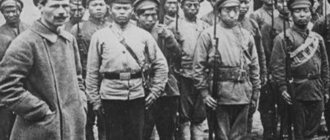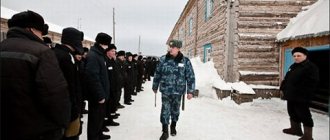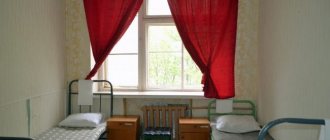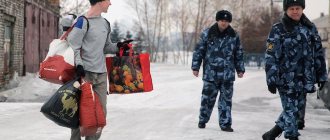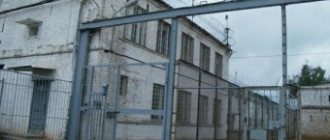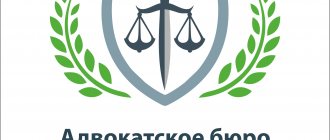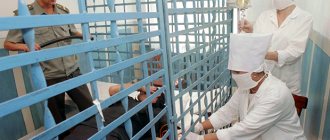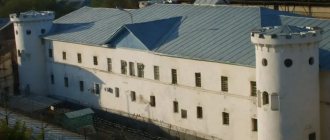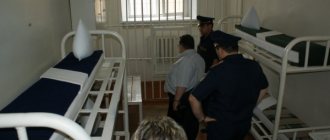Russia has experienced a huge number of upheavals over the past hundred years. Revolution, war, “hunger years”, years of stagnation, perestroika, redistribution of property, gangster 90s... During the time of Stalinist repressions, millions of people were in camps; after the war, all those captured were recognized as enemies of the Soviet state and were sent to a new stage; in the 90s, people tried to survive as best they could, many went into racketeering, and with the advent of legality they were sent to prison zones. As a result, by the beginning of the 21st century, prison life affected almost every family - if the person himself was not in prison, then among his relatives or friends there was always someone who had visited places not so distant. Finding a family now that does not have such a skeleton in their closet - among brothers, uncles, distant relatives or friends - is extremely difficult.
First option for zone classification
The first classification gives us the following definition of what the red zone is. According to this classification, zones differ in their population. The Red Zone is a correctional colony for former law enforcement officers. The black zone is a colony where civilians serve their sentences. Red zones in Russia according to this classification are intended not only for former police officers, but also for prosecutors, military personnel, employees of the Investigative Committee, bailiffs, and jailers. Putting them in the same cell with the contingent that they themselves brought to justice only means increasing crime in the colonies.
Which zones in Russia are “red” according to this classification? Former law enforcement officers serve their sentences in the following places:
- Nizhny Tagil, Sverdlovsk region, IK-13.
- G. Bor, Nizhny Novgorod region, Borsky district, IK-11.
- G. Skopin, microdistrict Oktyabrsky, Ryazan region, IK-3.
- G. Engels, Industrial zone, Saratov region, IK-13.
- Pechora town, Misha-Yag village, Komi Republic, IK-49.
- Republic of Mordovia, Zubovo-Polyansky district, Leplei village, IK-5.
- Irkutsk, IK-3.
Class interest
In 2021, the People's Policy Project, a think tank, published a study that rejected the "race" explanation for the disparity in American prison populations. After analyzing data on the race and income of prisoners, sociologist Nathaniel Lewis came to the conclusion that the main factor of stratification is not skin color, but the economic stratum to which the prisoner belongs.
White Americans are represented roughly evenly across all five income classes, while 40 percent of blacks in the United States are in the lowest income class, 20 percent are in the second-to-last income class, and only about 8 percent of them are in the upper class. Additionally, an overwhelming number of African American prisoners do not have a high school diploma.
Depending on the criterion - the likelihood of being put behind bars after arrest and the likelihood of imprisonment as such, the duration of imprisonment is more than a month and more than a year - the difference between blacks and whites is covered by the difference between poor and rich by at least half or even almost entirely: from 53.7 to 84 .8 percent.
The authors of the study, however, are confident that racism plays a significant role here: the capitalist system itself, in their opinion, discriminates against blacks. They concluded that a humane socialist economy would solve the racial problem in America's prisons, something that would likely appeal to members of the Black Guerrilla Family, Black Lives Matter, and everyone else who is convinced of the deep injustices of capitalism that exist in the United States. American society.
Read about how prisoners interact with each other, how they build a shadow economy, and how much marijuana you can buy for one package of canned mackerel.
Second example of zone classification
Nowadays, another meaning is increasingly used when dividing colonies by color. What is the red zone according to this classification? This is a colony where the administration and activists “run the show.” Here, interaction between prisoners and the zone administration is encouraged. Thieving traditions are strong in the “black” zone; in parallel with the administration, there is a strong “institution of overseers”; life is built on prison laws.
What is the difference between the red zone and the black zone? Features:
- Power lies with the “activists” and the administration.
- There is no free circulation of alcohol and drugs.
- The prisoners are busy working and do not hang around idle.
- It is customary to greet every employee.
Conditions of detention in a colony-settlement
The mildest type of punishment associated with imprisonment. Those sentenced to a term not exceeding 5 years are held here for crimes committed through negligence. Also, those prisoners who have proven themselves well in general and maximum security colonies are transferred here.
In a colony-settlement there is no strict security; here the concept of “under supervision” is more used. Convicts have the right to move without restrictions within the territory of the colony from waking up to bedtime. They are allowed to wear civilian clothes, receive parcels, use pocket money without restrictions, and receive visits. They live not in cells, but in dormitories. Moreover, if a convict has a family that would like to live with him, then this is not prohibited by the colony administration. Families are allowed to live in rented housing on the territory of the colony. But we must understand that this is not a resort; the administration of the colony settlement has the right to check such housing at any time of the day.
The work of such convicts is paid in accordance with labor regulations. And if you want, you can even get an education, but only in absentia and within the boundaries of the administrative-territorial entity.
Diversity of cultures
African-American gangs in prisons are often just cells of “traditional” street organized crime groups, such as the Bloods
and
Crips
, warring with each other based on old feuds and redistribution of drug markets.
But there are exceptions, and they are significant: a prison group called Black Guerilla Family
is built primarily on ideological principles. Members of this gang, founded in 1966 by George Jackson of the Black Panthers, define their ideals as “African-American Marxism-Leninism” and consider the fight against racism and the black revolution in the United States to be their goals. The symbol of the organization was a black dragon clutching a prison guard in its claws against the backdrop of a watchtower.
Hispanics, mostly Mexicans, are united in American prisons by the Mexican Mafia
(also known as "La Eme") and
"Nuestra familia"
, which means "our family" in Spanish.
These gangs, like African American gangs, originated in California and identify each other by wearing blue and red clothing. They are waging the longest criminal war in US history, which began with the theft of shoes by one bandit from another in 1968. At the same time, Nuestra Familia’s allies are left-wing radical Africans from the Black African Family, and on the side of the Mexican Mafia are white Nazis from the Aryan Brotherhood
.
Both groups are predominantly Chicano - Latino nationalists - and accept whites into their ranks, while other Latinos are more likely to join the so-called "Texas Syndicate"
, more closed to representatives of other ethnic groups.
Ethnicity is, of course, important for white organized crime groups: they are usually united by the idea of racial superiority. The most famous group called the Aryan Brotherhood
Formed in the same California prison, San Quentin, where the Black Guerrilla Family was founded, white prisoners initially banded together to defend themselves against black radicals, but soon outnumbered them in brutality. Now the gang is called the most authoritative and brutal in America. According to the principle of “blood in, blood out”, in order to join it, the candidate must attack a guard or a prisoner of a different race, and can only leave posthumously.
Portrait of Adolf Hitler - a standard subject for a tattoo of a Nazi gang member
Photo: TDCJ
Currently, the Brotherhood unites more than 20 thousand criminals throughout the country. That's less than 0.1 percent of all inmates, but the gang is responsible for about one in five murders inside the U.S. prison system, according to the FBI. Its members are identified by tattoos with Nazi symbols, clovers and the number “666” - they deny Christianity and mainly profess Scandinavian neo-paganism.
Neither the great cause of black liberation nor the belief in the superiority of the Aryan race prevents prison gangs from making money. Contract killings, extortion, racketeering, arms trafficking, production and distribution of hard drugs - for each of the above gangs these are common sources of income and a key part of daily activities both in prison and outside of it. The ideas of racial solidarity with which these associations began have long become a kind of facade for the standard activities characteristic of organized crime groups around the world.
Conditions of detention in a general regime colony
Here are those convicted of serious crimes, if this crime was committed for the first time. The second category is those convicted of crimes of minor and medium gravity, if the court found it impossible to reform in the conditions of a colony-settlement. And one more category - convicts who have reached the age of 18, who served their sentence in a correctional colony until they came of age. There are general regime colonies for both women and men.
Conditions here are harsher than in the settlements. Less freedom, more restrictions. They live in locked rooms. There are workdays: 8 hours of work, an hour break for lunch, according to the Labor Code of the Russian Federation. The number of dates is limited - 6 short-term and 4 long-term per year. The number of parcels is also limited - only six for the same period.
In general regime colonies there is also the opportunity to get an education and participate in cultural and sports events. Management, as a rule, creates all the conditions for this.
Conditions of detention in a maximum security colony
Persons whom the court considered the most dangerous to society and, accordingly, require strict isolation are kept here. These are those who have committed, for example, the intentional murder of two or more people or a contract killing. They also end up in such a colony for recidivism.
Convicts are kept in locked cells. Beds are in two or three tiers; an area of no more than 7 m² is allocated per prisoner. 4 parcels and 4 parcels per year are allowed; three long and three short dates. You cannot spend more than 2 minimum wages on food in the colony stores.
And, of course, the main difference is the contingent. In a maximum security colony, a “first mover” is a rarity. Most of those convicted are those who chose a life of crime as their life credo.
Conditions of detention in a special regime colony
People don’t end up here by accident, “by stupidity” or “by negligence.” It contains those criminal elements who have clearly been recognized as dangerous to society and who should not be among free people. Special regime colonies are colonies for those sentenced to life, for those sentenced to death, but who received a commutation of death by life imprisonment, and for those sentenced to 25 years - in practice, few of them survive to the end of their sentence.
Why can you end up in a special regime colony? These are the crimes that make the hair on the back of an ordinary law-abiding citizen stand on end. These are serial murders, serial rapes, terrorist attacks. Here sit cannibals and maniacs, sadists and fanatics. A prisoner who has committed a particularly serious crime while serving time in another colony can also end up here.
In colonies marked “special regime” there is no place for minors, women and men who have reached the age of 65 - the conditions for serving their sentences are too strict.
There are seven such colonies in Russia. Each has its own unofficial name: “Black Golden Eagle”, “White Swan”, “Vologda Pyatak”, “Torbeevsky Polar Owl”, “Mordovian Colony” and “Black Dolphin”. The living conditions can be examined in more detail using a specific example of the Black Dolphin colony.
Racial gangs
“Everything depends on race here. I mean, really everything,” says Jerry Metcalfe, who was convicted of manslaughter and weapons charges. — In the dining room, whites sit in one corner, blacks in the other. White people get their hair cut by a white barber, black people get their hair cut by a black barber. It's still the 1950s here - I mean, we only share drinking fountains. […] The only difference is that whites behind bars are often in the minority.”
Finding himself, deservedly or not, at the mercy of the American penitentiary system, the prisoner is faced with a cruel world, the population of which - more than 2.2 million people - is sometimes guided by the primitive laws of survival, strictly separating friends from foes, and is not afraid to resort to violence.
It is known that in terms of the number of convicts, the United States is significantly ahead of other states and ranks first in the world in terms of the ratio of prisoners to the total number of citizens. In some states, there are more than a thousand prison inmates per 100,000 residents, including children.
In some prisons, prisoners' uniforms are not one color, but stereotypically striped.
Photo: Andrew Burton/Getty Images
There are many reasons for this situation. Among them are overly strict laws and long sentences. People sometimes have to wait decades to get out of prison, and people have to adapt. The most obvious solution for many is joining a gang - and as a result, every tenth American prisoner is a member of one or another organized crime group.
Almost 40 percent of the American prison population is African American, compared with only 13 percent nationwide. According to 2010 data, for every 100 thousand adult American citizens there are 678 white male prisoners, 4.3 thousand blacks and 1.7 thousand of Hispanic origin.
"Black Dolphin": a prison for lifers
Correctional Colony No. 6 of the Office of the Federal Penitentiary Service for the Orenburg Region (official name) owes its poetic name to the fountain with a sculpture of a black dolphin located in the courtyard of the institution. This prison can house 1,600 inmates. Currently, 863 people are serving sentences there. The number of prison staff is even higher - 900 people. The administration of the colony strictly maintains security. Such precautions bear fruit - no one has ever escaped from this place.
The Black Dolphin prison for lifers is famous for its strict daily routine and harsh rules for keeping prisoners. Random people don't end up there - this prison is intended for the most hardened criminals. So, for example, Vladimir Nikolaev, a famous Russian cannibal, who in the 90s killed two of his drinking buddies and used their meat as food, is serving his sentence there. Nikolai Astanov will sit there until the end of his days - he killed an entire family and burned their bodies in the forest. The lives of these criminals and other non-humans are built according to a single algorithm, day after day, year after year:
- Rise at 6 am. From this moment until lights out, prisoners are prohibited from sitting or lying on their bunks.
- The size of the chambers is 4 x 5 square meters. m. In such a “cage” there are one or two prisoners. The “neighbors” are selected by a psychologist.
- Impossibility of being left alone: prisoners are monitored 24 hours a day, 7 days a week. It is forbidden to cover your head with a blanket. The duty officer comes by every 15 minutes.
- When transferred from a cell to other rooms, prisoners are blindfolded to disorientate them. They move bent over to eliminate the possibility of escape.
- There is no dining room here. Food is pushed through holes in the doors. The menu is not very varied - porridge, soup, bread.
- Every day, an hour and a half - a walk in the fresh air, in any weather. At this time, the administration checks the cameras for the presence of prohibited items.
“Black Dolphin” is not a prison where people end up “just like that,” having lost their way, through stupidity or misunderstanding. These prisoners are responsible for a truly enormous number of crimes. The number of lives that these 800-plus people took is more than 3,500. 4 lives for each criminal. Scary numbers.
Brother for brother
Prison gangs in the United States are strictly separated by skin color. This is an echo of past oppression - almost all the largest gangs were formed in the 60s of the last century. Then the state decided to end segregation in prisons and began to house prisoners together, regardless of race. But racism has not gone away. Prisoners expect their “friends” to be ready to help in a conflict situation, and those who do not provide this help are deprived of support and become victims themselves. Most convicts are involved in racial violence in one way or another.
Divided among themselves without the help of the state, criminals formed associations of thousands with a rich history of cooperation and enmity - not branches of gangs operating on the other side of the prison fence, but fundamentally new structures that influence the lives of their members outside the penitentiary system. In each prison, gangs seize territory, mark it with their signs and divide the market for illegal goods and services. Against the background of this, real wars with mass clashes and killings take place between them. The leaders of the groups are deservedly considered brilliant managers - despite all the efforts of the prison guards, they manage to manage the most complex processes. As a rule, they communicate with their subordinates using encrypted letters on very small pieces of paper.
The 33 prisons located in the state of California were built to house 80,000 inmates; now they accommodate more than 145 thousand people
Photo: Lucy Nicholson/Reuters
The Atlantic journalist Graham Wood shared his observation of the impending prisoner brawl: “At first it seems that we are seeing these terrifying men - tattooed killers, robbers and drug dealers - randomly walking around the courtyard. Some are stopped and searched by security, after which they adjust their clothes and continue to breathe fresh air. The first Latino approaches the concrete table, sits down and waits. The black prisoner goes to the horizontal bars and carefully looks at the people walking. The white guy, going out into the yard, immediately goes to the third point, near the basketball court. Another Latino occupies another table. Gradually it becomes obvious that they are following a tactic: each of them takes a place for their own.”
When several dozen prisoners gather in three groups in the yard, the guards also form a group and retreat to the fence. Describing what is happening in the yard, Wood writes that the criminals “move in such a coordinated and organized manner, as if they were obeying the instructions of invisible traffic lights.” “There are about thirty knives in this yard right now,” the security officer tells the journalist. “They hide them in their anus.”
Homemade knives are the main weapon in prison wars. Despite the fact that the administration severely punishes those who manufacture and store weapons, convicts continue to sharpen them. They are also not afraid to use them, despite the possible extension of the sentence - many gang members have already been sentenced to life imprisonment. In 2007, a massacre took place in Pelican Bay, resulting in dozens of casualties. Thanks to the efforts of the guards and doctors, only one prisoner among the wounded did not survive, and the administration confiscated 89 units of homemade weapons - sharpeners and batons.
